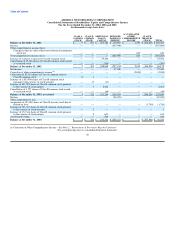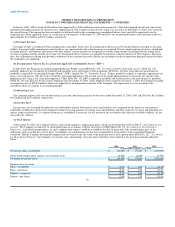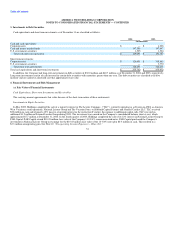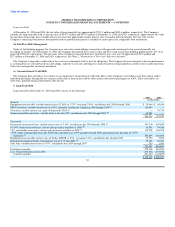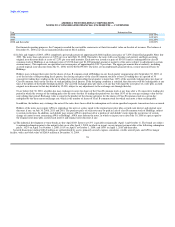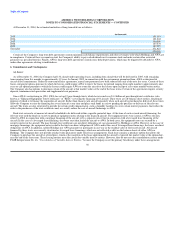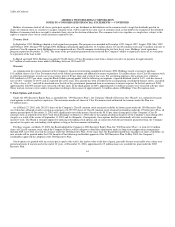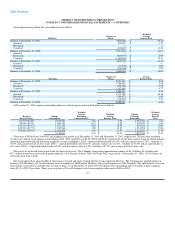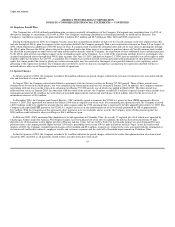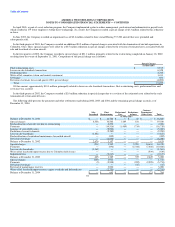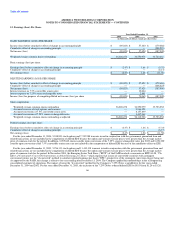US Airways 2004 Annual Report Download - page 59
Download and view the complete annual report
Please find page 59 of the 2004 US Airways annual report below. You can navigate through the pages in the report by either clicking on the pages listed below, or by using the keyword search tool below to find specific information within the annual report.
Table of Contents
AMERICA WEST HOLDINGS CORPORATION
NOTES TO CONSOLIDATED FINANCIAL STATEMENTS — CONTINUED
At December 31, 2004, the estimated maturities of long-term debt are as follows:
(in thousands)
2005 151,183
2006 101,042
2007 100,509
2008 107,570
2009 147,327
Thereafter 371,927
$ 979,558
Certain of the Company's long-term debt agreements contain minimum cash balance requirements and other covenants with which Holdings and AWA are
in compliance. Certain of these covenants restrict the Company's ability to pay cash dividends on its common stock and make certain other restricted
payments (as specified therein). Finally, AWA's long-term debt agreements contain cross-default provisions, which may be triggered by defaults by AWA
under other agreements relating to indebtedness.
6. Commitments and Contingencies
(a) Leases
As of December 31, 2004, the Company had 136 aircraft under operating leases, including four aircraft that will be delivered in 2005, with remaining
terms ranging from five months to approximately 19 years. In January 2002, in connection with the government guaranteed loan, AWA restructured its
aircraft lease commitments. Under the restructured lease agreements, annual rent payments have been reduced for each of the next five years. Certain of these
leases contain put options pursuant to which the lessors could require AWA to renew the leases for periods ranging from eight months to approximately nine
years or call options pursuant to which the lessors could require AWA to return the aircraft to the lessors upon receipt of six to nine months written notice.
The Company also has options to purchase certain of the aircraft at fair market values at the end of the lease terms. Certain of the agreements require security
deposits, minimum return provisions and supplemental rent payments.
Since AWA's restructuring in 1994, AWA has set up 19 pass through trusts, which have issued over $1.4 billion of pass through trust certificates (also
known as "Enhanced Equipment Trust Certificates" or "EETC") covering the financing of 54 aircraft. These trusts are off-balance sheet entities, the primary
purpose of which is to finance the acquisition of aircraft. Rather than finance each aircraft separately when such aircraft is purchased or delivered, these trusts
allow the Company to raise the financing for several aircraft at one time and place such funds in escrow pending the purchase or delivery of the relevant
aircraft. The trusts are also structured to provide for certain credit enhancements, such as liquidity facilities to cover certain interest payments, that reduce the
risks to the purchasers of the trust certificates and, as a result, reduce the cost of aircraft financings to AWA.
Each trust covered a set amount of aircraft scheduled to be delivered within a specific period of time. At the time of each covered aircraft financing, the
relevant trust used the funds in escrow to purchase equipment notes relating to the financed aircraft. The equipment notes were issued, at AWA's election,
either by AWA in connection with a mortgage financing of the aircraft or by a separate owner trust in connection with a leveraged lease financing of the
aircraft. In the case of a leveraged lease financing, the owner trust then leased the aircraft to AWA. In both cases, the equipment notes are secured by a
security interest in the aircraft. The pass through trust certificates are not direct obligations of, nor guaranteed by, Holdings or AWA. However, in the case of
mortgage financings, the equipment notes issued to the trusts are direct obligations of AWA and in the case of leveraged lease financings, the leases are direct
obligations of AWA. In addition, neither Holdings nor AWA guarantee or participate in any way in the residual value of the leased aircraft. All aircraft
financed by these trusts are currently structured as leveraged lease financings, which are not reflected as debt on the balance sheets of either AWA or
Holdings. The Company does not provide residual value guarantees under these lease arrangements. Each lease contains a purchase option that allows the
Company to purchase the aircraft at a fixed price, which at the inception of the lease approximated the aircraft's expected fair market value at the option date,
near the end of the lease term. These leasing entities meet the criteria for variable interest entities. However, they do not meet the consolidation criteria under
FASB Interpretation No. 46, "Consolidation of Variable Interest Entities," because the Company is not the primary beneficiary under these arrangements.
56


